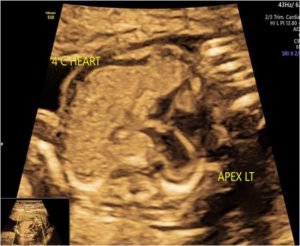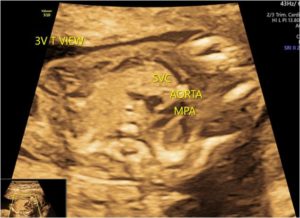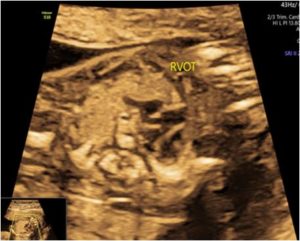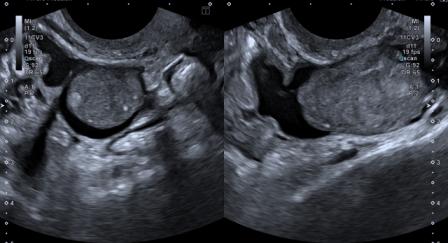Curious case of a very rarely missing fetal organ

A 20-years old primigravida presented for obstetric ultrasound at 18-weeks gestation.
The ultrasound findings were as follows:

Figure 1: The fetal heart is situated completely in the left hemithorax, with apex pointing left. The left lung parenchyma is not seen (absent). The right lung is homogeneously echogenic. No abnormal vascularity was seen in the right lung.

Figure 2: The 3VTV shows the normal vessels. Both the cardiac outlets were normal.

Figure 3: The main pulmonary and right pulmonary arteries are seen. The left pulmonary artery is not seen (absent).
Figure 4: Video – The fundic bubble is well visualized. Left lung is not seen and heart is in left hemithorax. Both diaphragms appeared intact.
Figure 5: Video – The left pulmonary artery is not seen (absent). Rest of the fetal cardiac structures appear unremarkable.
Rest of the fetal anatomical survey was normal. Based on the ultrasound findings of absent left lung and absent left pulmonary artery, a diagnosis of isolated unilateral pulmonary agenesis was made. The patient was, however, lost to follow-up.
Unilateral pulmonary agenesis is an extremely rare anomaly. Abnormal blood flow in the dorsal aortic arch during the embryonic phase has been suggested as the possible mechanism.[1] The pulmonary parenchyma, bronchus and pulmonary vasculature are all absent in case of pulmonary agenesis.
Ipsilateral shift of the mediastinal structures is often the first indicator of the diagnosis. The loss of volume in the affected hemithorax results in crowding of ribs.
There may be associated anomalies in the affected fetuses viz; cardiovascular (patent ductus arteriosus, patent foramen ovale), gastrointestinal (tracheoesophageal fistula, imperforate anus), genitourinary, or skeletal (limb anomalies, vertebral segmentation anomalies).[1] The incidence of chromosomal anomalies in not increased. Left lung agenesis is more frequently isolated than right lung agenesis.[2]
The common differential diagnoses to be considered are:
(a) Congenital diaphragmatic hernia: the stomach and / or bowel loops herniate in hemithorax causing contralateral shift of mediastinum.
(b) Congenital pulmonary airway abnormalities: the affected lung is large in size, shows multiple cysts or appears more echogenic, with contralateral mediastinal shift.
(c) Lung hypoplasia: lung parenchyma is seen but appears small, with ipsilateral mediastinal shift.
It is possible that right lung agenesis gets diagnosed more frequently, perhaps because of the greater mediastinal shift & higher incidence of associated anomalies.[2] This may also explain why prognosis is better with left lung agenesis.[2]
Fetuses with isolated pulmonary agenesis generally have a good prognosis.[3] These cases can be managed conservatively during pregnancy.[3] Delivery at a tertiary care institute should be considered keeping in-view the possibility of post-natal respiratory complications.
© Copyright Reserved
References:
1. Biyyam DR, Chapman T, Ferguson MR, Deutsch G, Dighe MK. Congenital lung abnormalities: embryologic features, prenatal diagnosis, and postnatal radiologic-pathologic correlation. Radiographics 2010;30(6):1721-38.
2. Meller CH, Morris RK, Desai T, Kilby MD. Prenatal diagnosis of isolated right pulmonary agenesis usinh sonography alone: case study and systematic literature review. J Ultrasound Med 2012;31(12):2017-23.
3. Russell BC, Whitecar P, Nitsche JF. Isolated unilateral pulmonary agenesis and other fetal thoracic anomalies. Obstet Gynecol Surv 2014;69(6):335-45.


















